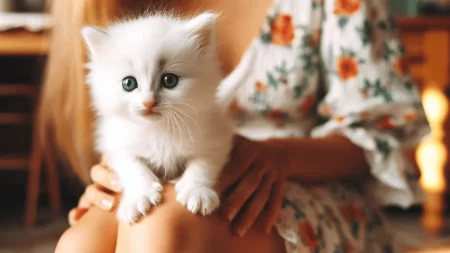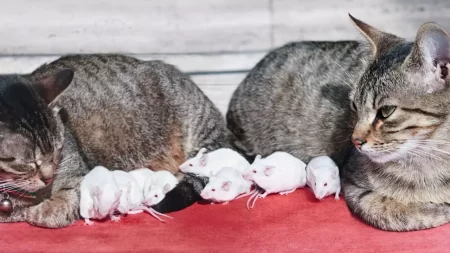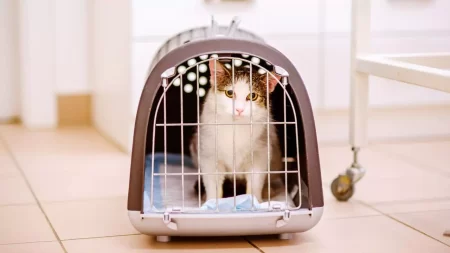We’ve all been there; our cats purring softly in our laps, kneading their paws into our arms as they look up longingly into our eyes. But do cats actually love us, or is it all a facade?
In this blog post, we’ll explore the question of whether cats are capable of loving their owners. Get ready to learn the answer – you may be surprised at what we discover!
It’s long been assumed that cats are independent and aloof creatures who don’t need or even want human interaction. But cats, like other animals, have surprisingly complex social behaviors. Research studies have shown that cats can form a bond with their owners that is similar to the bond between a parent and a child.
In 2018, a study published in Animal Behaviour found that cats may be equally as affectionate to their humans as dogs are – if not more so. The study of 78 cats showed that many felines demonstrate inspiring dedication and loyalty to their owners even after long periods apart from them.
Through the centuries, people have asked if their feline companions really feel love for them or if it’s just an illusion caused by well-timed meals and cuddles. To really understand how cats feel about us, we need to take a look at cat psychology and how we coexist with our furry friends.
What Is The Scientific Evidence?
The science behind cats’ feelings isn’t yet as easy to read as with dogs. Some people incorrectly assume that cats don’t develop strong bonds, but current research shows otherwise. Studies have shown that cats can, indeed, be very loving and attached to their owners—although in their own unique way.
Naturally, cats react differently to different people and situations depending on the individual cat’s personality and preferences, but in general, cats seem to show their affection for their primary human by:
- Grooming – licking or rubbing against their hair or skin
- Purring when petted or held
- Rubbing their head or body against a person’s hand or leg
- Interacting when talked to
- Initiating play
- Sleeping near or on top of a person.
In addition to being loving and engaging with humans, scientific experiments measuring the physiology of cat-human interactions suggest that cats seek contact with humans for pleasure (as opposed to fear) and actually experience “positive affective states” when interacting socially with humans—shows of contentment such as purring or slowly blinking the eyes similar behavior displayed towards other cats they may consider close friends. These results imply that felines can not only form an attachment but also experience pleasure toward it – something only seen up until recently in primates and other mammals previously thought too intelligent for domestication!
Do Cats Show Signs Of Affection?
Cats have long been known for their solitary behavior, but research tells us that cats form strong attachments to their owners. While some cats may be more aloof and less likely to show signs of affection than others, they’re still capable of loving human companionship.
In addition to purring, some cats enjoy being petted and groomed by humans. When a cat rubs his face against yours or even stiff-arms you with outstretched paws, it can be a sign that he’s content or happy in your presence. Cats have also been found to exhibit behaviors similar to baby talk when talking to people they trust or care about – a sure sign of affection.
Not all cats respond positively to petting and grooming from humans; it depends on each cat’s individual personality and preferences. That’s why it’s important to observe your cat before attempting any physical contact with him. If he seems timid or uncomfortable, step away and try again at a later time – when he’s in a better mood. Once your cat is comfortable enough with you and trusts you, he may become increasingly receptive toward cuddles and other forms of affection.
Are Cats Capable Of Forming Attachments?
Cats are creatures of habit and typically form attachments to their environment, including their owners. Whether this translates into love is a difficult thing to measure. Cats show signs of affection in different ways from humans and other animals – but evidence suggests cats may be capable of feeling love for by their owners.
In order to determine whether or not cats are capable of forming attachments, scientists have studied the behavior and communication of cats toward their owners. Studies have shown that cats can form secure attachments with humans and prefer their company to that of strangers, which indicates an emotional bond between the two parties. Cats also display behaviors such as kneading, chirping, purring, and licking that may be associated with love or joy when they interact with people they trust.
Studies have also found that cats become stressed when separated from their owners for long periods of time or moved to unfamiliar environments with strange people or animals. This behavior indicates a level of attachment that could be associated with love for an owner.
While cats cannot verbally express feelings as humans do, there is some evidence suggesting that they can form strong bonds with those around them – including the person who feeds them and cares for them every day!
What Is The Evolutionary Purpose Of Cats’ Attachment To Humans?
The unique relationship between cats and humans is founded in the evolutionary history of cats, although the idea that cats are ‘man’s best friend’ is still debated. Studies have found that cats view human companions as social partners and form a bond with their human caregivers. This behavior may be instinctual in some respects, allowing them to tolerate our presence and even seek comfort from us when they’re in need.
Cats seem to recognize familiar people and use them as a source of security, displaying signs of attachment such as purring when around their favorite people. It has also been suggested that this strong relationship may be due to their natural hunting abilities coming into play when playing with their owners – they learn to trust humans with their food in order to satisfy their needs, forming an evolutionary bond over time.
People who have experienced living with multiple cats can attest to the fact that each cat forges its own connection with its owners – some are more independent seeking out affection only sometimes, and others seek out cuddles much more often. Despite this wide range of attachment styles, it can be argued that often cats value a secure environment and reliable access to food above all else, thus creating a strong bond between pet and the owner even without all the typical cuddles and purring sometimes expected from pet relationships.
How Do Cats Show Their Love?
While cats may never verbally tell their human friends “I love you,” they certainly have ways of showing their affection. Through their actions, postures, and even vocalizations, cats can share how they feel toward the person in their life who matters most – you!
Felines express love through head-butting and rubbing. By pushing up against your legs or body, kitties are marking you with the scent of their facial pheromones which serve to strengthen bonds between social partners. When adding more purrs than usual during snuggle time, cats are expressing contentment and comfort in your presence. Furthermore, when bringing “gifts” from around the house like toys or pieces of fabric – cats are showing care for the people in their lives with offerings that serve as tokens of affection.
Cats demonstrate communication through eye contact and blinking slowly is often a display of trust: it is known as a kitty kiss! Similarly, localizing vocalizations such as trilling or chirping around humans suggest familiarity with one another: these sounds can also denote pleasure and excitement that arises when spending time together. An open-mouth smile – think whiskers back – also reveals satisfaction derived from interaction: cats share happiness by smiling at the people they care deeply about.
Tail twitches in particular can imply strong attachment; when tail tips turn toward humans amidst other body language signals it’s an indication your furry friend loves having you around! In conclusion, if your cat purrs incessantly while occasionally batting its eyelids or accompanying sweet meows with caresses – chances are it loves being near you.
How Can Owners Better Understand Their Cats?
Cats are often misunderstood because they are not as expressive as dogs, but this does not mean cats cannot love or form strong bonds with their owners. Cats express their feelings differently, often through affectionate behavior such as headbutting or snuggling up close. To better understand your cat and enhance the bond you share, it’s important to recognize these behaviors and to govern interactions with an awareness of what your cat needs.
Observing your feline companion’s behavior is key to understanding their feelings and how to care for them. Cats communicate through body language, vocalizations, and subtle scents that can be detected using scent glands around their face and flanks. Paying attention to even the subtlest signals can make a big difference in building the bond between you and your pet!
Interactions between you and your feline friend go beyond cuddles; activities like playing with toys or training involve connecting with each other on a deeper level. First, ensure that the game is enjoyable for your cat— they don’t always enjoy cuddles— then look for behaviors that indicate enjoyment like purring, kneading, or flicking tails. Some cats may even vocalize playfully during games! These games provide exercise for cats; keeping their minds active helps prevent boredom which can lead to behavioral issues in indoor cats.
In addition to providing physical activities, consider giving your pet mental stimulation by setting up puzzle feeders—these provide an interactive way for cats to eat while challenging them mentally! You can also provide treats throughout the day or outside of normal meal times to show extra love— this lets them know you’re thinking about them! A great way of expressing your appreciation for all the joys that furry friends bring every day is through regular brushing sessions which help develop a stronger bond as well as keep their coats healthy.
Conclusion
In conclusion, although cats and humans have different ways of expressing love, it’s very likely that cats do indeed love their owners. They show signs of attachment such as purring when petted, snuggling with you when sleeping, following you around the house, and meowing for attention – just to name a few. While cats may not be as outwardly affectionate as dogs, they still show signs of care and affection in their own special way.







